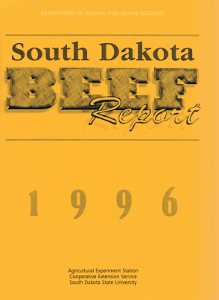Document Type
Report
Report Number
96-5
Publication Date
1996
Keywords
feed management, beef, feedlot
Summary
Gain efficiency by cattle fed high grain diets can be affected by feed delivery management (FDM). Restricted or limit feeding improves feed efficiency but can reduce ADG. This experiment was designed to evaluate if feeding near ad libitum intake while reducing the amount of variation between daily feed deliveries could provide feed efficiency advantages over unrestricted access to feed without restricting ADG. The FDM strategies for the 121-day feeding period included prescription intakes (PI) where variability between day to day feed deliveries were minimized or ad libitum intake (ALI) where feed was always available. Crossbred yearling steers (n = 76, initial BW 866 Ib ± 6.72) of mixed origin were stratified by BW and randomly assigned to one of two treatments then to one of five pens within a treatment. The 92% concentrate, 63 Mcal NE,/cwt diet, was fed to the PI group throughout the 121 –day study. Four step-up diets were fed over 12 days to adapt the ALI group to the 92% concentrate diet. Feed was delivered daily at 0730 and 1630. The bunks were slick for the PI treatment at 0700 69% of the days on feed and 40% for the ALI treatment (P< .01). The PI fed steers consumed less DM (P< .001) during interim periods days 1 to 29 and 58 to 85 (P<.05). The PI steers were more efficient days 1 to 29 (P< .03) and overall (P<.10). Carcass variables associated with yield grade were not affected (P>.10) by FDM and PI caused higher marbling scores (5.67 vs 5.31; P< .085), while percent choice did not differ, 74 vs 79% for the PI and ALI treatments, respectively. The PI treatment lowered (P< .05) feed cost $5.30/cwt gain. This experiment indicated that FDM can influence DM1 and feed efficiency without compromising ADG.
Number of Pages
5
Format
application/pdf
Language
en
Publisher
South Dakota State University
Rights
Copyright © 1996 South Dakota State University.
Recommended Citation
Bierman, S. J. and Pritchard, R. H., "Effect of Feed Delivery Management on Yearling Steer Performance" (1996). South Dakota Beef Report, 1996. 6.
https://openprairie.sdstate.edu/sd_beefreport_1996/6

